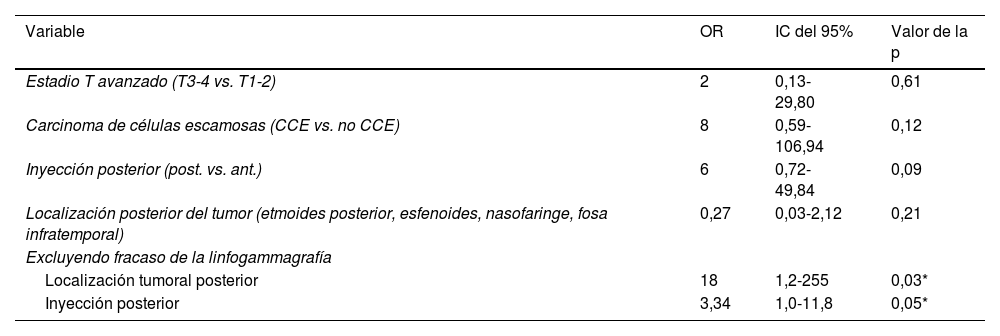Evaluar mediante linfogammagrafía in vivo y con detección SPECT/TC los patrones de drenaje linfático de los tumores del seno paranasal (SPN). Confirmar o rebatir la creencia de que el ganglio linfático retrofaríngeo (GLRF) se erige en el ganglio de drenaje índice para dichos tumores.
MétodosEstudio de cohorte prospectivo realizado en pacientes con tumores del SPN no tratados previamente y sin evidencia clínico-radiológica de metástasis a nivel ganglionar. La linfogammagrafía se realizó mediante la inyección peritumoral de sulfuro coloidal marcado con [99m]TcO4 y asistida por endoscopia nasal. Las inyecciones se clasificaron como anteriores o posteriores en función de una línea vertical que pasaba por el orificio del seno maxilar.
ResultadosSe incluyeron 17 pacientes. La linfogammagrafía identificó satisfactoriamente 17 ganglios centinelas en 15 pacientes, y no pudo evidenciarlo (fracaso de la linfogammagrafía) en 2 pacientes. Se observó que los lugares predominantes de drenaje del ganglio centinela fueron el GLRF (n=8; 47%) y el nivel I (n=7; 42%). Se identificó drenaje ocasional en el ganglio periparotídeo (n=1) y en el nivel II (n=1). Se observó drenaje linfático contralateral en 2 pacientes (en el nivel I y GLRF, respectivamente).
Las inyecciones anteriores drenaron predominantemente hacia el nivel I (6/8) y a GLRF (2/8), mientras que las inyecciones posteriores drenaron predominantemente a GLRF (6/7). El riesgo relativo de que el GLRF fuera identificado como ganglio centinela fue significativamente mayor en las inyecciones administradas posteriormente respecto a las administradas anteriormente (RR: 3,43; IC 95%: 1,0-11,8; p=0,05).
ConclusiónEl GLRF es considerado un ganglio de drenaje frecuente asociado a los tumores del seno nasal, y merece su atención rutinaria en todos los casos de tumor del seno nasal. La técnica de SPECT/TC con radiocoloide descrita aquí ofrece una excelente técnica in vivo para explorar y validar con mayores garantías las vías de drenaje linfático de estos tumores.
To evaluate by in vivo lymphoscintigraphy and SPECT-CT imaging, the lymphatic drainage patterns of para-nasal sinus (PNS) tumours. To confirm or refute the belief of the retropharyngeal lymph node (RPLN) being the significant draining lymph node for such tumours.
MethodsProspective cohort study conducted on previously untreated PNS tumours with no clinico-radiological evidence of lymph node metastasis. Lymphoscintigraphy undertaken by nasal endoscopic assisted peritumoral injection of 99mTc sulphur colloid. Injections were classified as anterior or posterior as per a vertical line along the maxillary sinus ostium.
ResultsSeventeen patients were included. Lymphoscintigraphy successfully identified 17 sentinel nodes in 15 patients and was unsuccessful (lymphoscintigraphy failure) in 2 patients. Predominant sites of sentinel lymphatic drainage were noted to be the RPLN (n=8; 47%) and level I (n=7; 42%). Occasional drainage was identified at the peri-parotid node (n=1) and at level II (n=1). Contralateral drainage was noted in 2 patients (level I-1 and RPLN-1).
Anterior injections drained predominantly to level I (6/8) and RPLN (2/8), while posterior injections drained predominantly to the RPLN (6/7). The relative risk of RPLN being identified as the sentinel node was significantly higher for posteriorly placed injections than for anteriorly placed injections (RR: 3.43; 95% CI: 1.0-11.8; P=.05).
ConclusionThe RPLN is noted as a frequent draining node for sino-nasal tumours and merits routine attention in all sino-nasal tumours. The radio-colloid SPECT-CT technique described here offers an excellent in vivo technique to further explore and validate the lymphatic drainage pathways of these tumours.











